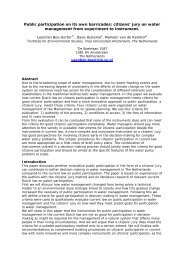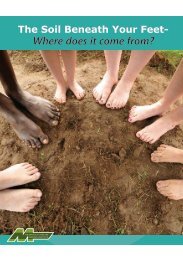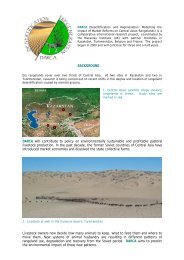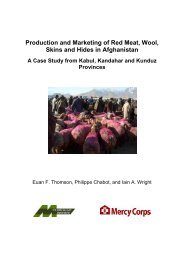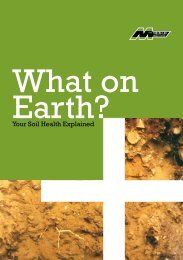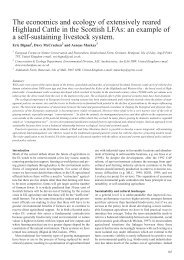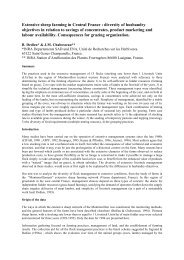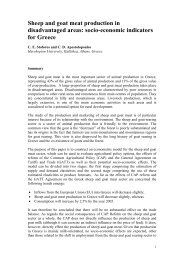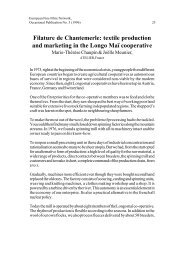Woodland Biodiversity - The Macaulay Land Use Research Institute
Woodland Biodiversity - The Macaulay Land Use Research Institute
Woodland Biodiversity - The Macaulay Land Use Research Institute
Create successful ePaper yourself
Turn your PDF publications into a flip-book with our unique Google optimized e-Paper software.
<strong>Woodland</strong> <strong>Biodiversity</strong><br />
A summary of research outputs from the Scottish Government’s<br />
“Environment – <strong>Land</strong> <strong>Use</strong> and Rural Stewardship” research programme<br />
1
Contents<br />
Introduction 3<br />
Clonal diversity and distribution of Pyrola<br />
media in Scotland 4<br />
Conserving <strong>Woodland</strong> <strong>Biodiversity</strong> in a<br />
Changing World – Lichen Epiphytes 6<br />
Wood ants and tree chemistry determine<br />
the population of crown invertebrates in Scots pine 8<br />
Impacts of woodland expansion and management<br />
on ticks and tick-borne diseases 10<br />
Effects of long-term browsing on regenerating birch 12<br />
<strong>Woodland</strong> expansion onto moorland:<br />
impacts on biodiversity and ecosystem services 14<br />
Multifunctional woodlands in the landscape 16<br />
Reappraisal of our zones of genetic conservation<br />
of Caledonian Scots pinewood 18<br />
Citation: Iason G.R. (ed.) 2011 <strong>Woodland</strong> <strong>Biodiversity</strong>.<br />
A summary of research outputs from the Scottish Government’s<br />
“Environment – <strong>Land</strong> <strong>Use</strong> and Rural Stewardship” research programme.<br />
<strong>Macaulay</strong> <strong>Land</strong> <strong>Use</strong> <strong>Research</strong> <strong>Institute</strong>, Aberdeen.<br />
2
Introduction<br />
Scotland’s relatively treeless landscape was formerly more heavily wooded, with many of<br />
the woodlands having been fragmented or removed in relatively recent times to facilitate<br />
grazing livestock. We are currently reversing this trend and are poised to accelerate natural<br />
regeneration and planting of new woodlands, under the Scottish Government’s target to<br />
increase woodland cover from 17% of the land area to 25% by 2050. It is aimed for native<br />
species to comprise 35% of the woodlands. A main driver of this move towards increased<br />
woodland cover is the aim to increase sequestration of atmospheric carbon in order to<br />
ameliorate climate change 1 . New woodlands can also form an integral component of an<br />
ecosystem approach to sustainable management of water and soil resources, as well as<br />
delivery of wood products, landscape enhancement, and community, recreational, wildlife<br />
and tourism benefits. Our conservation obligations for native woodlands derive from Annex 1<br />
of the EC Habitats Directive (Scots pine) and the UK <strong>Biodiversity</strong> Action Plan in which several<br />
other woodland types, including upland birch and oak woods, are Priority Habitats. Here we<br />
introduce some of the components of the Scottish Government’s “Environment – <strong>Land</strong> <strong>Use</strong><br />
and Rural Stewardship” research programme relating to <strong>Woodland</strong> <strong>Biodiversity</strong>, and describe<br />
some recently emerging results.<br />
In our current position, at the cusp of a rapid expansion of woodland regeneration and<br />
planting, it is important to be able to maximise the biodiversity and other benefits and<br />
services obtainable from this investment. <strong>The</strong> chapters presented here span a wide range<br />
of ecological levels from the autecology of single woodland species through to community<br />
diversity and processes of successional vegetation change, ecosystem function, large scale<br />
landscape and genetic variation across Scotland.<br />
Innovative molecular techniques have been developed and applied as conservation tools to<br />
study genetic variation in woodland herbs and a dominant tree species. <strong>The</strong>re can be large<br />
knock-on effects for other organisms of the characteristics and responses to environmental<br />
change of some dominant or foundation species, and their diseases. For example the<br />
chemical variation among individual Scots pine trees is a determinant of crown invertebrate<br />
populations and their exploitation by wood ants, which are themselves ecosystem engineers.<br />
<strong>The</strong> colonisation of moorland by birch represents a natural woodland expansion which<br />
influences the biodiversity and function of all other components of the system, and this<br />
process is sensitive to both the intensity and seasonal timing of browsing by large herbivores<br />
which we simulated in a long-term experiment. This is highly relevant given the reductions<br />
in grazing livestock now occurring in the uplands under current agri-environmental policies.<br />
Similarly, the large populations of sheep ticks in woodlands, and their positive response to<br />
current climate change has strong implications for the interactions between host animal<br />
populations (including man) and tick-borne disease.<br />
Cover photos: Joan Beaton<br />
Our woodland research also guides us in planning future woodlands for different biodiversity<br />
and landscape goals. Here we provide strategic management advice for re-establishment<br />
of communities of epiphytic lichens, which are a determinant of Scotland’s status as an<br />
international biodiversity hot-spot for crypotogamic plants. A mapping approach for spatial<br />
woodland planning at the landscape scale is based on maximising a range of benefits from<br />
multi-functional woodlands, and the basis of zones for seed collection from Scots pine, to<br />
maintain local genetic conservation, is revisited.<br />
<strong>The</strong>se scientific contributions will not only progress our understanding but will also help us<br />
to enjoy and benefit in many other ways from our future woodlands.<br />
Glenn Iason<br />
g.iason@macaulay.ac.uk 1<br />
Scotland’s Climate Change Adaptation Framework (2009)<br />
3
Clonal diversity and distribution of<br />
Pyrola media in Scotland<br />
Background<br />
Intermediate wintergereen (Pyrola media)<br />
is an evergreen perennial herb which occurs<br />
in heathlands and woodlands in Scotland.<br />
It has shown a marked decline in recent decades,<br />
leading to its inclusion in Scottish Natural<br />
Heritage’s ‘Species Action Framework’.<br />
However, establishing its current conservation<br />
status is hampered by two key factors. Firstly,<br />
when not in flower Pyrola media is difficult to<br />
distinguish from the closely related species<br />
Pyrola minor (Common wintergreen) (Photo 1).<br />
Photo 1: Pyrola media (left) and Pyrola minor (right) [Photos Jane Squirrell]<br />
4
• Similar patterns of clonal diversity were<br />
detected in Pyrola minor.<br />
Photo 2: A patch of Pyrola. How many genetically distinct<br />
individuals [Photo Jane Squirrell]<br />
This is a common problem as failure to flower is<br />
a frequent occurrence. Secondly, as these species<br />
occur in patches (rather than as individual plants)<br />
it is difficult to know exactly how many genetically<br />
distinct individuals and are present (Photo 2).<br />
To clarify the distribution and abundance of<br />
Pyrola media we have used genetic tools to<br />
(a) assess the extent of clonal growth<br />
(b) to distinguish between Pyrola media<br />
and Pyrola minor.<br />
Approach<br />
Assessments of clonal diversity of the two Pyrola<br />
species were undertaken using two different DNA<br />
fingerprinting techniques (amplified fragment<br />
length polymorphisms (AFLPs) and Simple<br />
Sequence Repeats (SSRs)). If clonal growth is<br />
the sole means of reproduction, all individual<br />
plants in a given place should have identical<br />
DNA profiles. If there is no clonal growth, all<br />
individuals should have distinct DNA profiles.<br />
To develop a diagnostic assay to distinguish<br />
Pyrola media from Pyrola minor, we examined<br />
the DNA sequence of several DNA regions using<br />
well identified reference material of either<br />
species. We searched for DNA differences which<br />
could tell the two species apart, and which<br />
would also enable us to develop a simple test<br />
for screening on larger sample sizes.<br />
Results<br />
Clonal diversity:<br />
• Clonal diversity differed among patches: the<br />
largest clone occupied approximately 20m 2 .<br />
More commonly patches this size consist<br />
of 2–3 clones, and even small patches<br />
(e.g. 1m x 1m) may contain multiple clones.<br />
Distinguishing between species:<br />
• In the region of the Internal Transcribed<br />
Spacers of nuclear ribosomal DNA (nrITS), we<br />
detected consistent DNA sequence differences<br />
between Pyrola media and P. minor.<br />
• <strong>The</strong>se differences enabled the design of a<br />
simple assay in which we fragmented the DNA<br />
region to give a diagnostic ‘banding pattern’<br />
(Photo 3).<br />
P. media P. minor P. media<br />
Photo 3: DNA based-assay which distinguishes Pyrola media<br />
from Pyrola minor. Each ‘column’ represents a different<br />
sampled individual. All individuals of Pryola media have one<br />
type of banding pattern, all individuals of Pryola minor have<br />
another<br />
• This cost- and time-effective assay was then<br />
used to obtain identifications for samples<br />
of unknown identity (e.g. non-flowering<br />
individuals).<br />
Conclusions<br />
Clonal growth is important, but not the sole<br />
means of local reproduction for this species.<br />
Adjacent plants often represent genetically<br />
different individual but seed production and<br />
recruitment is also important for this species.<br />
<strong>The</strong> development of a simple diagnostic assay<br />
has enabled us to clarify the fine scale<br />
distribution of Pyrola media by establishing<br />
which non-flowering patches belong to this<br />
species, and which belong to the more common<br />
Pyrola minor. This enhanced understanding of<br />
the species distribution and genetic structure<br />
makes it more straightforward to assess<br />
conservation threats and design conservation<br />
strategies.<br />
Authors: Jane Squirrell & Pete Hollingsworth (RBGE),<br />
Joan Beaton, Dave Sim & Glenn Iason (MLURI).<br />
Contact: Pete Hollingsworth (p.hollingsworth@rbge.org.uk)<br />
5
Conserving <strong>Woodland</strong> <strong>Biodiversity</strong><br />
in a Changing World – Lichen Epiphytes<br />
Background<br />
Scotland has world-renowned epiphyte<br />
communities, especially those<br />
characterising the ‘Celtic Rainforest’<br />
of the Scottish west coast (Photos 1 & 2). In<br />
Scottish woodland, the species richness of lichen<br />
epiphytes (hundreds of species) may be an order<br />
of magnitude higher than the trees on which they<br />
grow (5–10 species). <strong>The</strong> microhabitat provided<br />
by epiphytes has important consequences across<br />
the forest food-web: e.g. increasing the biomass<br />
and diversity of invertebrates. However, this<br />
diversity hangs in the balance. Lichen epiphytes<br />
have been impacted by deforestation in Scotland,<br />
and more recently, through intensification of<br />
woodland management. Additionally, lichen<br />
epiphytes are extremely sensitive to long-range<br />
Photo 1: A single pine twig laden with epiphytic lichens<br />
air pollutants, are responding to global warming,<br />
and have been developed as high resolution<br />
bioindicators for woodland ecosystem structure<br />
and biodiversity.<br />
<strong>The</strong> conflicting demands we place on<br />
Scotland’s landscapes, coupled with large-scale<br />
emerging threats such as climate change and<br />
transboundary pollution, mean that we require<br />
a conservation strategy that is adaptive at a local<br />
scale in order to counter these large-scale threats.<br />
RBGE research uses epiphytes as a model<br />
system, demonstrating how local woodland<br />
management might offset the negative effect<br />
of climate change on biodiversity.<br />
6
Photos: Chris Ellis<br />
Cross-Scale Interactions and <strong>Biodiversity</strong><br />
Protection<br />
• ‘Habitat specificity’ of lichen epiphytes<br />
changes along climatic gradients.<br />
• Under optimal climatic conditions a suite of<br />
lichen epiphytes occur in a wide variety of<br />
woodland, whereas under sub-optimal climatic<br />
regimes, the same lichen epiphytes become<br />
more restricted in their occurrence e.g. only<br />
occurring in ‘ancient’ woodland.<br />
Photo 2: Sphaerophorus globosus – a fruticose lichen<br />
which occurs on old trees along Scotland’s west coast<br />
Approach<br />
Our inventory work generated field-sampled<br />
species lists for habitats of high conservation<br />
status, focussing on Scotland’s native aspen<br />
stands (Populus tremula L.) and juniper scrub<br />
(Juniperus communis L.). <strong>The</strong>se data were<br />
supplemented by c. 250,000 geolocated lichen<br />
records, edited by RBGE staff, and uploaded<br />
onto the National <strong>Biodiversity</strong> Network<br />
(www.nbn.org.uk).<br />
Local woodland habitat might be managed to<br />
provide a small scale solution to offset large<br />
scale negative climate impacts: i.e. the possible<br />
shift with global warming from an optimum to a<br />
sub-optimum climate (Fig. 1). Our findings fully<br />
support a Government commitment to expansion<br />
of native woodlands. However, our work also<br />
indicates that in order to benefit epiphyte<br />
diversity, this process of forest regeneration<br />
cannot be ad hoc, and must be carefully targeted,<br />
by maximising habitat heterogeneity, as well as<br />
buffering existing sites with high species richness.<br />
Scotland’s Extinction Debt<br />
• Lichen species richness sampled from the<br />
modern landscape was explained by 19th<br />
century woodland extent and fragmentation,<br />
and not by the present-day extent and<br />
fragmentation of woodland.<br />
• <strong>The</strong>refore the impact of 20th century forest<br />
management is not yet expressed by current<br />
lichen communities.<br />
It may be a mistake to conserve areas of high<br />
species richness by assuming that current<br />
conditions (extent and isolation of woodland)<br />
provide adequate protection. Rather, we should<br />
target reforestation of native trees in buffer zones<br />
around species-rich woodland remnants, in order<br />
to secure their future lichen biodiversity.<br />
<strong>Land</strong>scape occupancy<br />
Fig. 1: Comparison of the occurrence of Scotland’s oceanic<br />
epiphytes in the present-day landscape (horizontal dashed<br />
line) with their occurrence under two climate change<br />
scenarios (2050s high and low greenhouse gas emissions),<br />
though including the positive effects of increasing woodland<br />
cover (curved dotted lines). Where the lines intersect,<br />
increasing woodland cover offsets negative climate impacts,<br />
maintaining the occurrence of species. See Ellis et al. (2009)<br />
Journal of Biogeography, 36, 302-313.<br />
Contact: Christopher Ellis (c.ellis@rbge.ac.uk)<br />
7
Wood ants and tree chemistry<br />
determine the population of crown invertebrates<br />
in Scots pine<br />
Background<br />
Wood ants are an integral component<br />
of native boreal pinewoods (Pinus<br />
syvlestris). One of the most important<br />
and enduring interactions is between the wood<br />
ants and the trees themselves. Wood ants show<br />
strong allegiance to particular foraging routes into<br />
tree canopies, where they collect honeydew from<br />
tended aphids, and predate other invertebrates,<br />
including defoliators, as sources of protein.<br />
<strong>The</strong>y thereby have a large impact on biodiversity.<br />
Tree choice by wood ants is not well understood.<br />
Within pinewoods, there is considerable<br />
genetically-based variation between individual<br />
trees including in the chemical composition of<br />
monoterpenes in particular: some trees contain<br />
δ 3 -carene in their needles whilst other trees<br />
Photo 1: Ants have a large impact on the ecology<br />
of forest ecosystems<br />
contain none. <strong>The</strong>se volatile compounds give<br />
pine trees their characteristic smell and mediate<br />
its interactions with herbivorous invertebrates,<br />
which may influence the foraging potential of a<br />
particular tree for wood ants. We investigated<br />
whether there was any relationship between<br />
tree choice by wood ants and pine tree<br />
monoterpenes, and how these factors influenced<br />
the populations of crown invertebrates.<br />
Approach<br />
<strong>The</strong> two true wood ant species occurring in<br />
Scotland are the Scottish wood ant, Formica<br />
aquilonia, and the hairy wood ant, Formica<br />
lugubris. <strong>The</strong> foraging behaviour of these two<br />
8
No of Arthropods (Non-Aphids)<br />
• Aphids, Diptera larvae, and Lepidoptera larvae<br />
dominated among prey items.<br />
• Ants foraged more in trees with lower<br />
concentrations of the monoterpene δ 3 -carene<br />
in their needles.<br />
• Trees with zero δ 3 -carene contain higher<br />
populations of crown (non-aphid)<br />
invertebrates than trees that contain δ 3 -carene<br />
in their needles, but this effect is only evident<br />
when ants do not forage in the tree (Fig. 1).<br />
250<br />
sed<br />
200<br />
150<br />
100<br />
50<br />
Photos: Gabor Pozsgai<br />
0<br />
No Ants Ants<br />
Fig. 1: <strong>The</strong> number on non-aphid arthropods on Scots pine<br />
trees in relation to whtehr the trees were foraged by ants,<br />
and whether the trees’ needles contained δ3-carene (red<br />
bars) or no δ 3 -carene (blue bars). SED : standard error<br />
of difference.<br />
Photo 2 : <strong>The</strong> Scottish wood ant Formica aquilonia<br />
ants was studied within Ballochbuie native<br />
pinewood in north-east Scotland. A large number<br />
of trees were analysed for their monoterpene<br />
composition and a representative sub-group<br />
of 45 were selected for further study of their<br />
ecology. Over two years these trees were visited<br />
monthly, and ant foraging activity monitored.<br />
Ant and non-ant trees were identified. <strong>The</strong><br />
crown invertebrate community was quantified<br />
by experimentally enclosing branches in insect<br />
proof nets on trees used by ants as compared<br />
with trees not used by ants.<br />
Ant foraging patterns<br />
• 56% of our trees were foraged by ants.<br />
• <strong>The</strong> average distance between nest and tree<br />
was 13m with a maximum of 44m.<br />
• Average ant territory size was estimated to<br />
be 590m 2 .<br />
• Honeydew dominated the diet throughout<br />
the year constituting 94–99% of loads.<br />
Conclusions<br />
Ants have a profound influence on the<br />
invertebrate population of Scots pine trees and<br />
the influence of a single ant colony spreads<br />
widely within the forest. <strong>The</strong> size of crown<br />
invertebrate populations (of non-aphids) in<br />
Scots pine trees is greatest in trees containing<br />
no δ 3 -carene, but the greater ant predation here<br />
leads to fewer invertebrates in these trees.<br />
<strong>The</strong> contrasting positive effects of ants on aphid<br />
populations are being investigated. <strong>The</strong>se results<br />
demonstrate the complex interactive effects of<br />
tree chemistry and the presence of ants on crown<br />
invertebrate populations. As ecosystem engineers<br />
wood-ants have strong effects not only on forest<br />
ecosystem function, but also on biodiversity<br />
which should be considered in the genetic<br />
planning of forests to maximise biodiversity.<br />
Authors: Jenni Stockan & Glenn Iason (MLURI)<br />
Contact: Jenni Stockan (j.stockan@macaulay.ac.uk)<br />
9
Impacts of woodland expansion and<br />
management on ticks and tick-borne diseases<br />
Background<br />
Scotland has a heterogeneous landscape<br />
with a mosaic of habitats such as<br />
grasslands, moorlands and woodlands.<br />
Our diverse woodlands are managed for<br />
recreation, commercial timber, biofuels, and<br />
conservation purposes, and each type has a<br />
different community of organisms, including<br />
ticks (Ixodes ricinus), tick-borne pathogens and<br />
their vertebrate hosts. Reported incidence of<br />
tick-borne disease (such as Lyme disease) has<br />
been increasing alarmingly over the last decade<br />
in Scotland. <strong>The</strong> Scottish Government aims to<br />
increase woodland cover in Scotland from<br />
17% to 25% over the next 40 years. How will<br />
this affect disease risk<br />
Photo 1: An engorged female adult tick<br />
We aimed to determine (a) the role of<br />
woodlands as habitats for ticks and (b) how<br />
woodland management such as fencing and<br />
culling deer can help control tick populations.<br />
Approach<br />
To determine the role of woodlands as habitats<br />
for ticks, and the effect of culling deer, we<br />
surveyed 77 sites throughout Scotland. We<br />
counted ticks by dragging blankets and used<br />
deer dung as a proxy for deer abundance. To<br />
determine the effect of woodland fencing on<br />
ticks, we surveyed ticks in 18 forests: nine fenced<br />
to exclude deer and nine unfenced.<br />
10
nymph abundance index<br />
nymph abundance index<br />
nymph abundance index<br />
Results<br />
• Ticks were most abundant in woodlands<br />
compared to open habitats such as heather<br />
moorland and grasslands (Fig. 1). This is<br />
because woodlands tend to have more tick<br />
hosts than open habitats, and the woodland<br />
canopy creates a favourable, mild microclimate<br />
that aids tick survival and host-seeking<br />
behaviour. A related project found more ticks<br />
infected with the Lyme disease pathogen in<br />
semi-natural deciduous/mixed woodland<br />
compared to coniferous woodland. Seminatural<br />
woodlands tend to have more small<br />
mammals and birds that are hosts to the<br />
pathogen of Lyme disease.<br />
35<br />
30<br />
• <strong>Woodland</strong>s that were protected from<br />
deer damage by use of deer-proof fencing<br />
contained far fewer ticks than similar, adjacent,<br />
woodlands that allowed access by deer<br />
(Fig. 3).<br />
5<br />
4<br />
3<br />
2<br />
1<br />
0<br />
fenced unfenced<br />
Fig. 3: Forests that were fenced to exclude deer contained<br />
fewer ticks<br />
Photo: Richard Hewison<br />
25<br />
20<br />
15<br />
10<br />
5<br />
0<br />
Heather/Bog Grasslands Semi-natural<br />
woodland<br />
Conifer<br />
plantaon<br />
Fig. 1: More ticks were counted in woodlands than in open<br />
habitats<br />
• Ticks increased with increasing deer numbers<br />
(Fig. 2), implying that managing deer numbers<br />
for woodland protection would also be<br />
beneficial in reducing ticks and tick-borne<br />
disease risk.<br />
9<br />
8<br />
7<br />
6<br />
5<br />
4<br />
3<br />
2<br />
1<br />
0<br />
0 0.5 1 1.5 2 2.5 3 3.5 4<br />
deer abundance index<br />
Figure 2: Fewer ticks were counted in areas with fewer<br />
deer. <strong>The</strong> large variation is due to differences in habitat and<br />
alternative hosts<br />
Conclusions<br />
• <strong>Woodland</strong> expansion is likely to increase<br />
tick abundance. <strong>The</strong>refore, we might predict<br />
that risk of Lyme disease will increase as<br />
woodland cover increases. This will depend on<br />
woodland type, and trade-offs will need to be<br />
assessed between the cost of increased risk<br />
of Lyme disease and the benefits of increased<br />
biodiversity.<br />
• However, standard woodland management<br />
techniques could help mitigate this risk.<br />
Excluding deer using deer-proof fencing or<br />
culling is likely to reduce tick abundance and<br />
Lyme disease prevalence in the woodland.<br />
• It is important to carefully consider all the<br />
issues relating to deer reduction and fencing,<br />
in terms of wider biodiversity impacts, social<br />
and cultural impacts, and economics.<br />
Contact: Lucy Gilbert (l.gilbert@macaulay.ac.uk)<br />
11
Effects of long-term browsing<br />
on regenerating birch<br />
Background<br />
Within the Scottish highlands, where<br />
downy birch (Betula pubescens)<br />
is prevalent, free-ranging sheep<br />
and deer have open access to many areas of<br />
semi-natural woodland. Government targets to<br />
increase the area of native woodland (including<br />
birch) depend on management of browsing<br />
herbivores to allow successful regeneration.<br />
Wild deer numbers are controlled mainly by<br />
shooting and fencing but for domestic sheep,<br />
numbers and timing of grazing can both be easily<br />
manipulated. Thus, for sheep there is potential<br />
to devise a range of seasonal management<br />
options to secure regeneration of birch whilst<br />
still allowing grazing for agricultural benefits.<br />
We therefore designed an experiment to<br />
examine: how birch saplings respond to different<br />
timing and severity of browsing damage<br />
Approach<br />
We established an experiment in 2000 at two<br />
Photo 1: Corrimony plot 1, August 2001 compare to photo 2<br />
sites with large numbers of regenerating birch<br />
(Betula pubescens) saplings within heatherdominated<br />
vegetation: Drynachan in the northeast;<br />
Corrimony in the western highlands. Three<br />
replicate plots were fenced at each site and the<br />
following browsing treatments were applied<br />
every year: factorial combinations of severity<br />
(0 (control), 33% and 66% shoot removal) x<br />
timing (clipped during dormancy, at budburst,<br />
or late summer). Each treatment combination<br />
was applied to 60 different saplings per site.<br />
Clipping was used to simulate browsing, to<br />
enable complete control of severity and timing<br />
of damage. All saplings at the start of the<br />
experiment were within 10cm of vegetation<br />
height as this is considered the stage of greatest<br />
vulnerability to browsing. Growth and size of all<br />
saplings was measured every year at the end<br />
of the growing season (Photo 3), for a total<br />
of 10 years (Photos 1 and 2).<br />
12
Photo 2: August 2010<br />
Photos: Alison Hester<br />
Photo 3: Measuring birches in midgeheaven!<br />
Results<br />
Timing and severity of browsing both had strong<br />
significant effects on all growth parameters<br />
(Fig. 1) as follows:<br />
• As expected, heavier browsing had more<br />
detrimental effects on growth.<br />
• Browsing in late summer was more<br />
detrimental to saplings than browsing in<br />
winter or spring.<br />
• Sapling mortality increased dramatically<br />
after about 5 years of browsing treatments:<br />
mortality was highest for heavily late-summerbrowsed<br />
saplings.<br />
• <strong>The</strong> two sites showed the same direction of<br />
impacts but growth rates were very different:<br />
at Corrimony 38% of unbrowsed saplings<br />
had grown above 1m height after 10 years<br />
(Photo 2), whereas none of the heavily late<br />
summer-browsed saplings grew above 1m.<br />
At Drynachan
<strong>Woodland</strong> expansion onto moorland:<br />
impacts on biodiversity and ecosystem services<br />
Background<br />
Scotland is currently only sparsely wooded<br />
with woodland covering about 17% of the<br />
land area. <strong>The</strong> Scottish Government aims<br />
to increase this to 25% by 2050 and woodland<br />
expansion onto moorland is one way to achieve<br />
this target. Pine and birch woodlands are the<br />
two native types of woodland that most readily<br />
establish on moorlands (Photo 1). Caledonian<br />
pinewoods are included within Annex 1 of the<br />
EC Habitats Directive and both Caledonian<br />
pinewoods and upland birch woodlands are<br />
Photo 1: Birch woodland colonising adjacent moorland<br />
Priority Habitats within the UK <strong>Biodiversity</strong> Action<br />
Plan. Both woodland types together make up the<br />
majority of the remaining fragments of native<br />
woodland in Scotland today and will readily<br />
expand, given the right conditions.<br />
<strong>The</strong> long-term research described below<br />
addresses the question: How does woodland<br />
expansion onto moorland affect biodiversity and<br />
ecosystem services<br />
14
mites/m²<br />
Decomposion (%)<br />
Photo: Alison Hester<br />
Approach<br />
Three different experiments have been used in<br />
this work to date:<br />
1 In the 1970’s a series of sites<br />
(chronosequences) were identified where birch<br />
woodland had naturally colonised moorland;<br />
changes at these sites and their neighbouring<br />
moorland have now been studied for 40 years.<br />
2 In 1980 three new sites were established each<br />
with a series of plots; half were planted with<br />
birch and half were left as open moorland.<br />
3 In 2005 a new experiment was established<br />
where both birch and pine trees were planted<br />
on moorland, with and without exclusion of<br />
large grazing herbivores.<br />
Using these long-term experiments we are<br />
examining how woodland colonisation on<br />
moorland drives changes in above- and belowground<br />
biodiversity and ecosystem function,<br />
using a combination of field data and controlled<br />
experimental data.<br />
When birch colonises moorland the following<br />
changes occur:<br />
Changes in biodiversity<br />
• <strong>The</strong> vegetation changes from heatherdominated<br />
to grass- and herb-dominated<br />
understorey.<br />
• <strong>The</strong> number and diversity of soil mites,<br />
collembola (spring tails) and earthworms<br />
increase (Fig. 1).<br />
• <strong>The</strong> soil microbial community changes<br />
from being fungal-dominated to bacteriadominated.<br />
• <strong>The</strong> species of fungi change.<br />
Changes in soil properties<br />
• Soil acidity decreases.<br />
• Soil phosphorus and bulk density increase.<br />
• Total soil carbon and depth of organic matter<br />
decrease.<br />
• Soil moisture decreases.<br />
Changes in ecosystem services<br />
• Rates of litter decomposition increase (Fig. 1).<br />
• Increased rate of nitrogen mineralisation.<br />
• Less carbon is stored in vegetation and litter in<br />
some 20 year old birch woodland vegetation<br />
than in moorland vegetation.<br />
• Less carbon is stored in the soil under 20 year<br />
old birch trees, planted on moorland, than in<br />
the moorland soil.<br />
Summary<br />
Colonisation of moorland by birch woodland<br />
drives changes in above- and below-ground<br />
biodiversity: this leads to changes in soil chemical<br />
properties and ecosystem services such carbon<br />
storage, decomposition and nutrient cycling.<br />
Authors: Ruth Mitchell, Alison Hester, Stephen Chapman &<br />
Lorna Dawson (MLURI)<br />
Contact: Ruth Mitchell (r.mitchell@macaulay.ac.uk)<br />
50000<br />
15<br />
40000<br />
10<br />
30000<br />
20000<br />
5<br />
10000<br />
0<br />
0<br />
Birch<br />
Heather<br />
Birch<br />
Heather<br />
Fig. 1: <strong>The</strong> succession to birch from heather results in a) greater abundance of soil mites and b) higher rates of decomposition<br />
15
Multifunctional woodlands<br />
in the landscape<br />
Background<br />
Numerous conservation and restoration<br />
efforts in developed countries, including<br />
woodlands, are now based on the<br />
premise of recognising and stimulating the<br />
creation of landscapes that can provide multiple<br />
and diverse benefits, including ecological, social<br />
and economic. <strong>The</strong> incorporation of multifunctional<br />
woodlands into sustainable landscapes<br />
requires policy and analytical tools at the<br />
landscape level.<br />
We have concentrated our study of multifunctionality<br />
on small woodlands in the lowlands,<br />
where they can provide multiple benefits. For<br />
example, the simplified landscapes associated<br />
with the introduction of intensive agriculture,<br />
have led to a reduction in biodiversity. At the<br />
same time, opportunity for recreation in such<br />
landscapes has declined along with their visual<br />
amenity. <strong>The</strong> notion of multi-functionality<br />
is therefore at the heart of efforts to link<br />
ecological concepts of biological functions with<br />
the economic concept of total economic value<br />
and ecosystem services. We have explored<br />
opportunities to describe the geographic<br />
heterogeneity of biodiversity, visual amenity<br />
and recreation potential of woodlands across<br />
the landscape of the NE of Scotland in search<br />
of potential ‘multiple win locations’ which<br />
we called ‘multifunctional hotspots’.<br />
16
Approach<br />
We have developed a method to identify and<br />
map areas where such coincidence of multiple<br />
functions is realised, in order to identify<br />
suitable target areas for the creation of small<br />
multifunctional woodlands.<br />
Potential for biodiversity: This approach is<br />
based on 16 important species identified by<br />
the NE <strong>Biodiversity</strong> Action Plan. We mapped<br />
the importance for biodiversity in the landscape<br />
based on the habitat suitability for each of these<br />
species.<br />
Potential for visual amenity: This was based<br />
on the viewing population (using traffic data<br />
and travel distance from urban areas) and<br />
accounting for the general preference of the<br />
public for the amount of woodland they like to<br />
see in the landscape, the amount of woodland<br />
already visible in the local landscape and the<br />
actual visibility of grid cells in the landscape from<br />
(public) points of observation.<br />
Potential for recreation: This was based on<br />
estimates of the expected number of visitors<br />
at any location which was inversely related to<br />
distance by road to where people live. <strong>The</strong> map<br />
also takes account of substitute sites of woodland<br />
recreation, i.e. people living in an area with little<br />
woodland cover are assumed to be willing to<br />
travel relatively longer distances for the purpose<br />
of woodland recreation.<br />
Results<br />
Combining all three maps found that despite<br />
giving precedence to each of the three criteria<br />
in turn, there is a ‘win-win-win’ area that<br />
is independent of which criterion is given<br />
precedence (Fig. 1). <strong>The</strong> yellow and red areas<br />
are those most suited for the planting of new<br />
woodlands because these new woodlands would<br />
deliver all of the three benefits above.<br />
Conclusion<br />
This approach can be used to find multiple win<br />
areas and areas where there might be trade-offs<br />
between a high number of criteria that could be<br />
preferred by the public.<br />
Contact: Alessandro Gimona (a.gimona@macaulay.ac.uk)<br />
High<br />
Low<br />
Figure 1: Multifunctional areas in the NE of Scotland agricultural landscape<br />
17
Reappraisal of our zones of genetic<br />
conservation of Caledonian Scots pinewood<br />
Background<br />
Caledonian Scots pine (Pinus sylvestris)<br />
woods cover less than 1% of their previous<br />
extent and are protected under the EC<br />
Habitats Directive. Scotland has 100% of the UK<br />
Caledonian pinewoods, which persist in 84 small<br />
fragments, the core areas of which range from<br />
1-2500ha (Photo 1). Current guidelines for the<br />
conservation of British tree species recommend<br />
that any planting stock should be derived from<br />
local seed sources, assuming that it is best suited<br />
to that particular local environment.<br />
Photo 1: <strong>The</strong> Caledonian pinewood at Coille Coire Chulic<br />
proportion of variation between populations<br />
in the monoterpenes, a group of genetically<br />
heritable volatile plant secondary metabolites,<br />
previously commonly used as pseudo-genetic<br />
markers (Fig. 1). Since the delineation of the Scots<br />
pine origin zones in the 1980s there have been<br />
considerable advances in analysis of both these<br />
chemicals and of genetic material (DNA) that<br />
permits direct identification of the genotypes<br />
of Scots pines. We re-examined the basis of<br />
the current seed zones for Scots pine.<br />
For Scots pine, seven ‘origin zones’ have been<br />
identified based upon the relatively small<br />
18
Current Origin Zones<br />
East Central<br />
North<br />
North Central<br />
North East<br />
North West<br />
South Central<br />
South West<br />
Results<br />
• <strong>The</strong> biochemical analysis identified two zones<br />
that are distinct from the remainder – 1) in the<br />
North-West of Scotland and 2) another group<br />
comprising the Abernethy and Rothimurchus<br />
populations (Fig. 2a).<br />
• For molecular DNA markers only the Shieldaig<br />
population in North-West Scotland appears to<br />
be different from the others (Fig. 2b).<br />
Photo: Ben Moore<br />
Fig. 1: Map showing the seven current origin zones<br />
for Scots pine. Larger dots show the 21 study populations,<br />
three in each zone<br />
Approach<br />
We collected and analysed pine needle samples<br />
from 30 trees in each of 21 of our original native<br />
Caledonian pinewoods (three populations in each<br />
of the seven current origin zones). We applied<br />
principal components and hierarchical cluster<br />
analysis to identify the variation between the<br />
Scots pine populations after using the latest<br />
techniques for the analysis of monoterpenes and<br />
newly developed Simple Sequence Repeat DNA<br />
markers.<br />
Revised Zones<br />
2a Mono and sesquiterpenes<br />
Conclusions<br />
<strong>The</strong> molecular markers (DNA) do not necessarily<br />
represent characteristics of the trees that may<br />
affect their survival or reproduction. Neither<br />
chemical nor molecular markers show the<br />
population level differentiation needed to<br />
inform a comprehensive conservation strategy.<br />
As an alternative we should consider whether<br />
characteristics of trees, such as growth or<br />
the timing of bud burst, form a better basis to<br />
investigate and classify differences between our<br />
Scots pine populations. Further research work<br />
is needed to quantify the tolerance of Scots<br />
pine from different origins to different climatic<br />
conditions in order to ensure the long-term<br />
persistence of regenerating populations under<br />
changing climatic regimes.<br />
2b Neutral DNA markers<br />
Figure 2: Maps showing which of the 21 study populations<br />
were distinct from the others, based on revised analysis<br />
of a) pine needle mono- and sesquiterpenes. Two groups<br />
of populations were identified (red dots:Shieldaig, Ben<br />
Eighe and Loch Clair and Rhiddoroch); and Abernethy and<br />
Rothiemurchus (blue dots) and b) neutral genetic markers;<br />
only Shieldaig was distinct from the others.<br />
Authors: Glenn Iason & Ben Moore (MLURI);<br />
Joanne Russell (SCRI); Pete Hollingsworth (RBGE) and<br />
Richard Ennos (University of Edinburgh).<br />
Contact: Glenn Iason (g.iason@macaulay.ac.uk)<br />
19
This booklet summarises some of the key findings<br />
concerning woodland biodiversity that have arisen from<br />
the Scottish Government Rural and Environment <strong>Research</strong><br />
and Analysis Directorate’s funded research programme<br />
“Environment – <strong>Land</strong> <strong>Use</strong> and Rural Stewardship”.<br />
<strong>The</strong> <strong>Research</strong> Programme involved researchers from:<br />
Biomathematics and Statistics Scotland<br />
<strong>Macaulay</strong> <strong>Land</strong> <strong>Use</strong> <strong>Research</strong> <strong>Institute</strong><br />
Royal Botanic Garden Edinburgh<br />
Scottish Agricultural College<br />
Scottish Crop <strong>Research</strong> <strong>Institute</strong><br />
<br />
<br />
Further information can be found at<br />
http://www.programme3.net/<br />
http://www.knowledgescotland.org/



